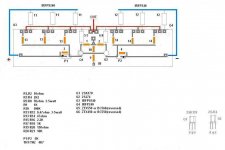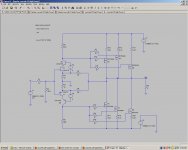Thanks for the update, Jack. Keep up the good work 🙂Note that the mounting hole for the Fairchild devices seems designed for a metric screw. I have drilled it out to accommodate US/UK screw sizes without ill effect.
I also received some TO-220 analogs to the TO-247's which are now difficult to source. Hopefully I can test these in the next couple of weeks.
By the way, the US Post Office just reported this morning that they had a software meltdown for package tracking in the US. Most packages mailed from October 1st this year can't be tracked.
Note that the mounting hole for the Fairchild devices seems designed for a metric screw. I have drilled it out to accommodate US/UK screw sizes without ill effect.
Thanks for that information Jackinnj, I had done the same and thought that may have been the reason my F5 had a premature death. Good to know.[/COLOR]
I also received some TO-220 analogs to the TO-247's which are now difficult to source. Hopefully I can test these in the next couple of weeks.
By the way, the US Post Office just reported this morning that they had a software meltdown for package tracking in the US. Most packages mailed from October 1st this year can't be tracked.
Good thing they're working on fixing Health Care next![/COLOR] Not Political
Ron
Have there been many F5 deaths while within the original design parameters?
I'm curious because mine runs about 16 hours a day and as of yet I have not added any protection for the speakers.
I'm curious because mine runs about 16 hours a day and as of yet I have not added any protection for the speakers.
JackinNJ said:By the way, the US Post Office just reported this morning that they had a software meltdown for package tracking in the US. Most packages mailed from October 1st this year can't be tracked
Boy, I wouldn't want to be the guy (DBA?) responsible for that meltdown.
Have there been many F5 deaths while within the original design parameters?
I'm curious because mine runs about 16 hours a day and as of yet I have not added any protection for the speakers.
Just check for offset every few weeks and when you turn on/off amp/speakers watch for excursion which will indicate DC.
You probably knew that but just in case.
Uriah
Have there been many F5 deaths while within the original design parameters?
I'm curious because mine runs about 16 hours a day and as of yet I have not added any protection for the speakers.
CBR,
My fault entirely, this was my first attempt at building a SS amp. Very much a Noob.
The Amp is stable and a great performer. So say those who have built them correctly, and those of us who had the pleasure of attending BA3.
Chocolate is the appropriate adverb. Just like Nelson says.
BTW, "CBR", any reference to the dog?
Ron
CBR,
My fault entirely, this was my first attempt at building a SS amp. Very much a Noob.
The Amp is stable and a great performer. So say those who have built them correctly, and those of us who had the pleasure of attending BA3.
Chocolate is the appropriate adverb. Just like Nelson says.
BTW, "CBR", any reference to the dog?
Ron
No, CBR is the motorcycle I ride. Luckily Honda has kept the CBR designation for many years - I haven't had to change this username since I picked it in the early 90's. Ironically the model of the bikes have been 600F2, F3, F4 and now 1000RR - which might be why this line of amps caught my attention.
My F5 has also been rock solid despite my numerous attempts to improve it. It literally runs all day every day at levels from barely audible to much louder than I would have thought such few watts could provide. My speakers are known to be amp killers (vintage infinity - highly reactive, low impedance and low efficiency), but this amp has dealt with them very well so far. The only precautions I take are an oscilloscope on the outputs to watch for clipping. People who know me don't believe me when I say this, but the F5 has displaced my Adcom GFA-555ii as my daily amp. I never would have believed I could be this happy with less than 150 watts per channel. I am typically a horsepower guy.
The one thing I did differently is that I have the heatsinks turned inwards and a (nearly) silent 120mm fan that moves air over them and over the power supply without moving any air over the amp boards themselves - they only get convection. My heatsink temps end up being in the mid 40's and the case temperature is usually in the mid 50's.
and now 1000RR
Boy, you live life dangerous
It literally runs all day every day at levels from barely audible to much louder than I would have thought such few watts could provide.
Sounds like a describtion of my RVF400(Honda ofcourse)
My heatsink temps end up being in the mid 40's and the case temperature is usually in the mid 50's.
Creative convection cooling is...cooool
But I dont understand how air inside amp can be hotter than your heatsinks
Though I plan to use convection cooling solely to cool down the supply caps
Trying to figure out a way to shield the caps from heatsink, and Jfets maybe

Man, I sure hope this cascoded input is going to happen, keeping F5 nice and hot fore another round
Last edited:
Oh, I mean the case temperature of the output MOSFETs themselves is in the 50's.
The RVF's were cool little bikes, never see them around here.
The RVF's were cool little bikes, never see them around here.
ım fine and youhi huseyin how are you..i wish you will draw a good pcb for us and we will group buy...
yeah ı drew a pcb of f5,ıts measurement are about 20/3cm
here it is
An externally hosted image should be here but it was not working when we last tested it.
Looks nice
Maybe I would work on getting power supply connection away from Jfets
And output lines to speaker looks smallish
I might work on a layout so simple and straightforward that anyone is able to hardwire it without any problem
Maybe I would work on getting power supply connection away from Jfets
And output lines to speaker looks smallish
I might work on a layout so simple and straightforward that anyone is able to hardwire it without any problem
Note that the mounting hole for the Fairchild devices seems designed for a metric screw. I have drilled it out to accommodate US/UK screw sizes without ill effect.
I also received some TO-220 analogs to the TO-247's which are now difficult to source. Hopefully I can test these in the next couple of weeks.
By the way, the US Post Office just reported this morning that they had a software meltdown for package tracking in the US. Most packages mailed from October 1st this year can't be tracked.
Hopefully this didnt affect shipments after 10/20, where does one get the tracking number from?
P>S> Had Email from Tech-DIY, I shouldnt have even been concerned. How great someone is willing to put all this and more together for an easy purchase.
Russellc
Last edited:
thanh1973, have you built one yet?
Not yet. But I will definitely be giving it a go.
Thanks Nelson for the idea, what do you think about the simulations.
Last edited:
Not yet. But I will definitely be giving it a go.
I sure hope you will
I have searched spec sheet
But I dont understand
2SK135/2SJ50 appears to be TO-3 power devices

Attachments
Last edited:
Yes they are power devices. Probably overkill, but so far this has given the best results. If I find any other devices that work even better then I will post an update.
There are other options in to-247 packages.
There are other options in to-247 packages.
Last edited:
I dont know, but would these be any good
2SA1145-Y (150V Toshiba Audio Transistor) - Buy Online @ AmpsLab
2SA1145-Y (150V Toshiba Audio Transistor) - Buy Online @ AmpsLab
however need more components to turn them on.
wow🙂 which components would that be
How about a bit higher supply voltage, maybe 2x 30-35Vdc ?
How high supply voltage would be possible fore this cascode curcuit ?
Last edited:
That circuit is running at +/- 40 V dc
You need 4V at the base of the transistors. Something like a zener and maybe some resistors.
You need 4V at the base of the transistors. Something like a zener and maybe some resistors.
Last edited:
- Home
- Amplifiers
- Pass Labs
- F5 power amplifier

